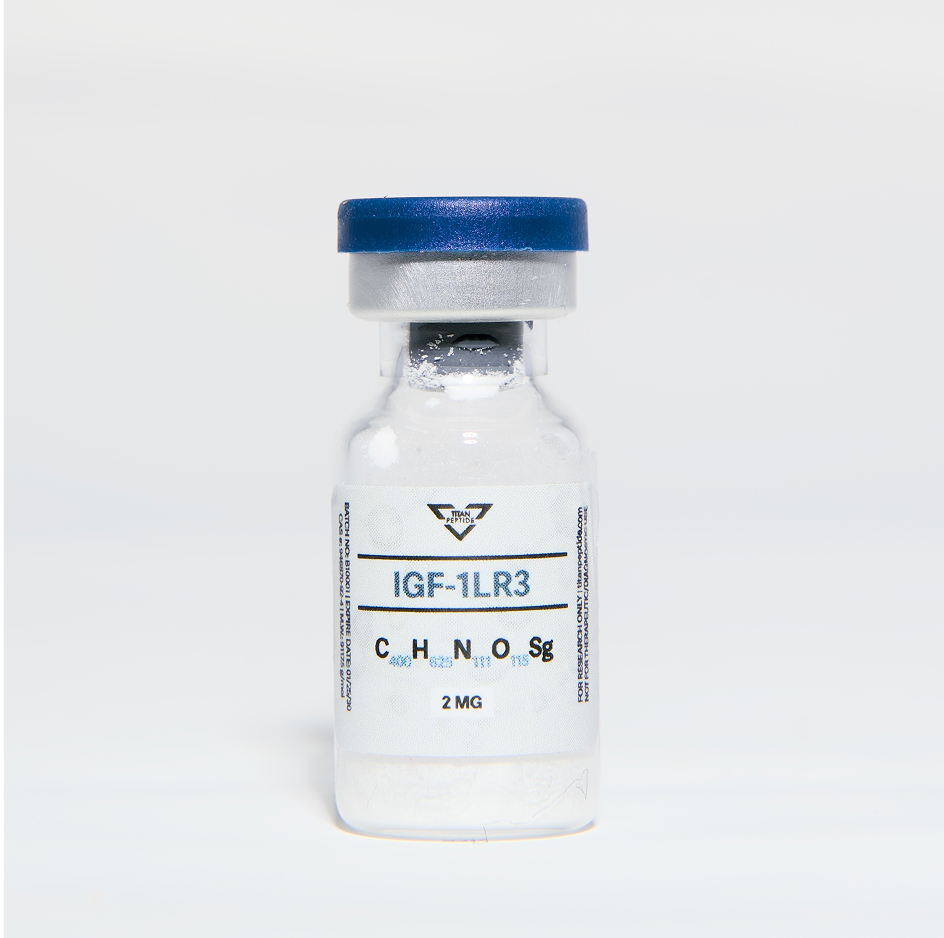

IGF-1LR3
CJC-1295 is a 30-amino acid peptide analog of GHRH designed to stimulate the release of growth hormone from the anterior pituitary. Unlike MOD GRF (1-29), CJC-1295 contains a drug affinity complex (DAC) that binds to albumin, significantly extending its half-life and duration of action in experimental settings. This prolonged activity allows for sustained growth hormone release rather than short, pulsatile bursts.





A long-acting analog of insulin-like growth factor-1 (IGF-1), modeled for laboratory research.
IGF-1 LR3 (Long Arg3 IGF-1) is a synthetic analog of the naturally occurring insulin-like growth factor-1, a peptide hormone involved in growth, development, and metabolism. It is modified to have a 13-amino-acid extension at the N-terminus and a substitution of arginine for glutamic acid at position 3, which significantly reduces its binding affinity to IGF-binding proteins (IGFBPs).
This modification extends its half-life from minutes to hours in research settings, allowing more IGF-1 to remain bioavailable to target tissues. IGF-1 LR3 is studied extensively in models involving muscle growth, recovery, cell differentiation, and neuroprotection.

Titan research and immune system function
Muscle Growth & Repair:
Investigated for its potential to stimulate muscle cell proliferation, differentiation, and protein synthesis.
Cell Regeneration:
Studied in models of tissue repair, wound healing, and regenerative medicine.
Neuroprotection:
Research explores IGF-1 LR3’s role in supporting neuron survival and synaptic plasticity.
Metabolic Modulation:
Examined for its ability to influence glucose metabolism and insulin sensitivity in various tissues.
Aging & Longevity Research:
Used in studies examining anabolic decline and tissue degeneration over time.
Titan research and immune system function
Extended Bioavailability:
Reduced IGFBP binding results in longer circulation time and greater receptor activation.
Anabolic Signaling Pathways:
Activates the PI3K–Akt pathway, promoting protein synthesis and inhibiting protein breakdown.
Satellite Cell Activation:
Enhances the repair and growth of skeletal muscle fibers via myogenic precursor cell activation.
(1) Shavlakadze, T., et al. (2005). IGF-1 overexpression induces skeletal muscle hypertrophy and blocks age-related muscle loss. → Demonstrated robust muscle fiber growth in mice treated with IGF-1.[Journal of Gerontology: Biological Sciences, 60(10), 1369–1377]
(2) Florini, J. R., et al. (1996). IGF-1 as an anabolic hormone in skeletal muscle. → Showed IGF-1's role in activating satellite cells, increasing protein synthesis, and hypertrophy in various tissues. [Hormone Research, 45(1-2), 9–17]
(3) Calder, K. M., et al. (2009). IGF-1 LR3 enhances muscle regeneration and accelerates satellite cell activation. → Describes accelerated hypertrophy and recovery from muscular injury in animal models using LR3 analog
.svg)
The graph shows the effect of IGF-1 LR3 on muscle growth over four weeks, based on animal data with inferred human outcomes. At Week 1, muscle growth markers increase by 15%, indicating that IGF-1 LR3 begins to stimulate growth fairly quickly. By Week 2, the effect grows to 35%, showing a clear upward trajectory.
By Week 4, muscle growth markers reach 60% above baseline, representing a significant enhancement compared to earlier weeks. The steady increase suggests that IGF-1 LR3 may provide progressive benefits for muscle development when used over time.
Form:
Lyophilized Powder
Storage (unreconstituted):
- Store at 2–8 °C (refrigerated), protected from light.
- For long-term storage, keep at –20 °C.
- Avoid repeated freeze–thaw cycles.
Reconstitution:
- Reconstitute with sterile water for injection or 0.9% NaCl immediately prior to use. Use aseptic technique.
Storage (after reconstitution):
- Store at 2–8 °C.
- Use within 7–10 days.
- Discard any unused solution after this period.
- Handle under sterile conditions.
- Do not shake vigorously (may cause peptide denaturation).
- Inspect visually for particulate matter or discoloration before use.
Issued for quality verification of tested material.
Feedback highlighting proven outcomes and reliability.













